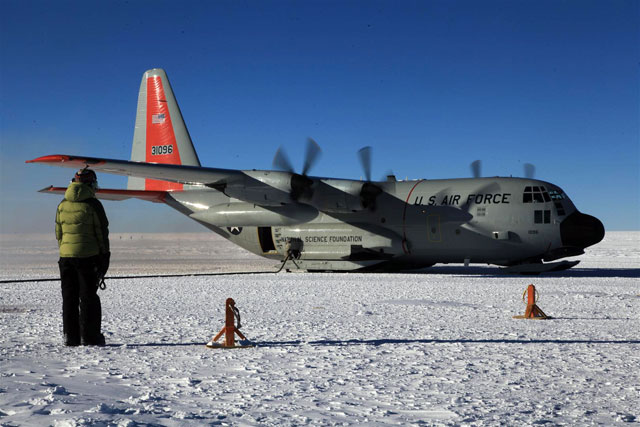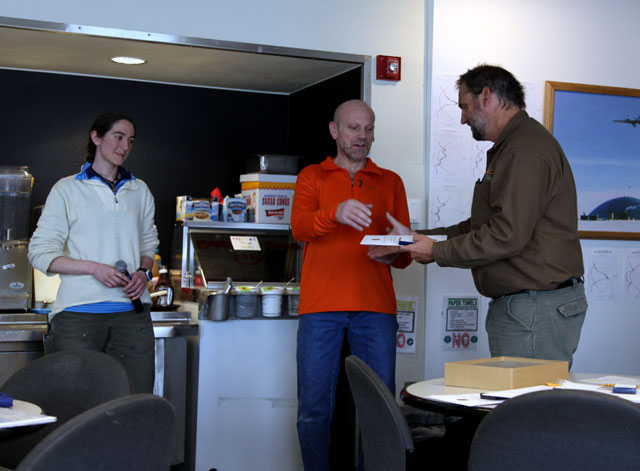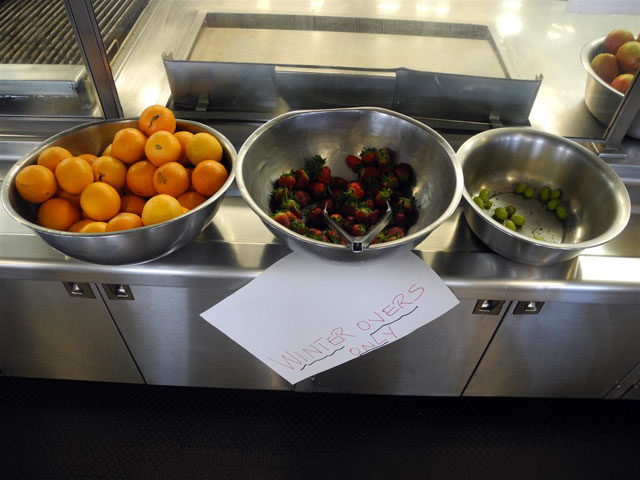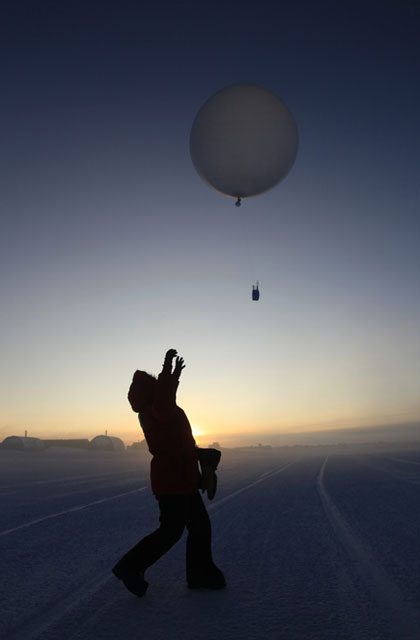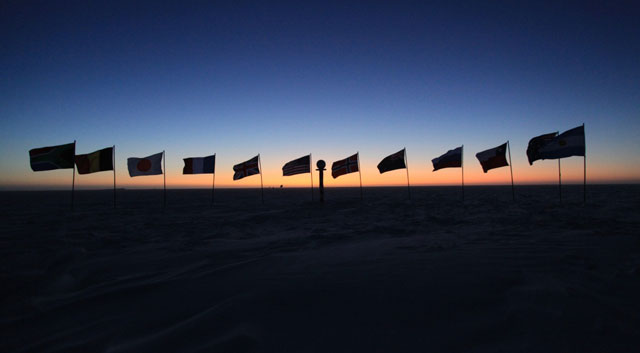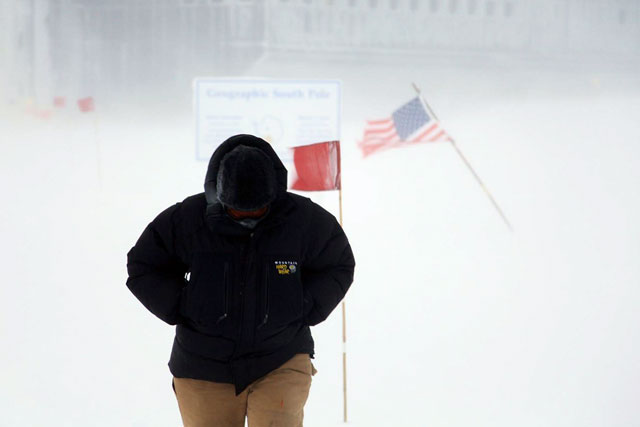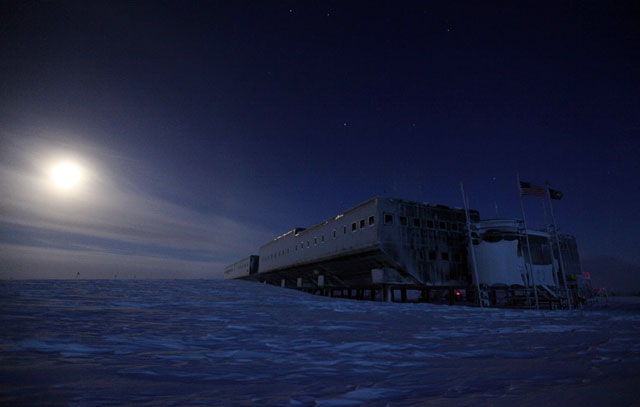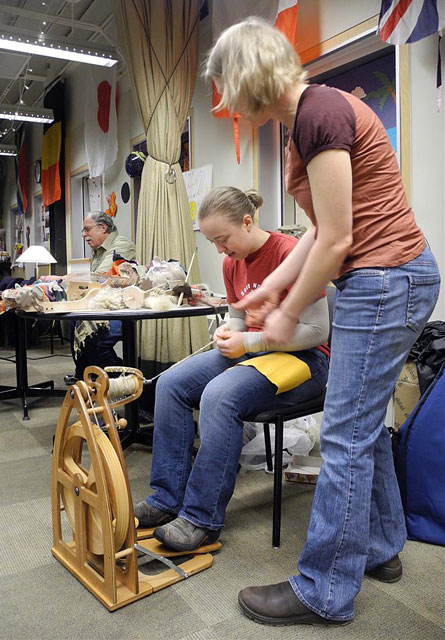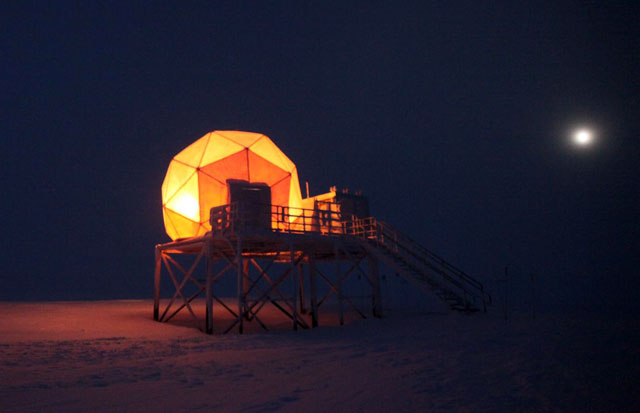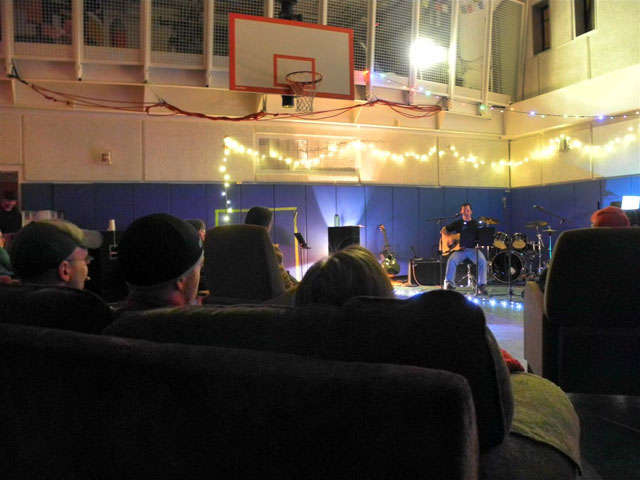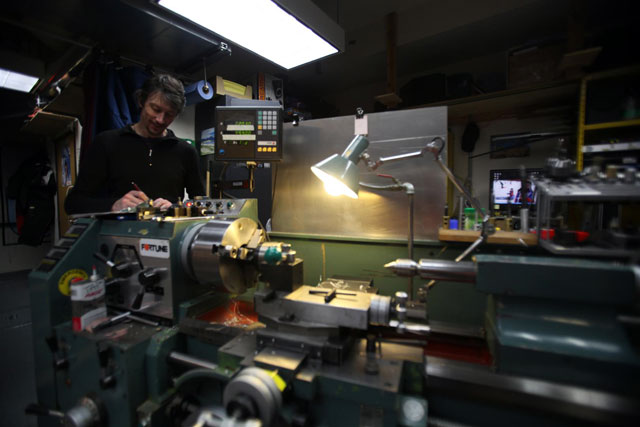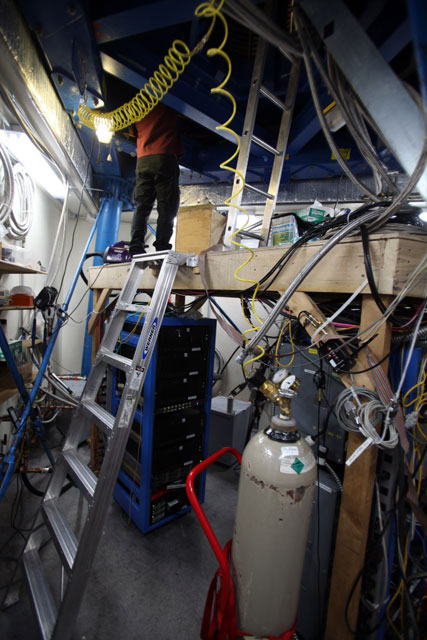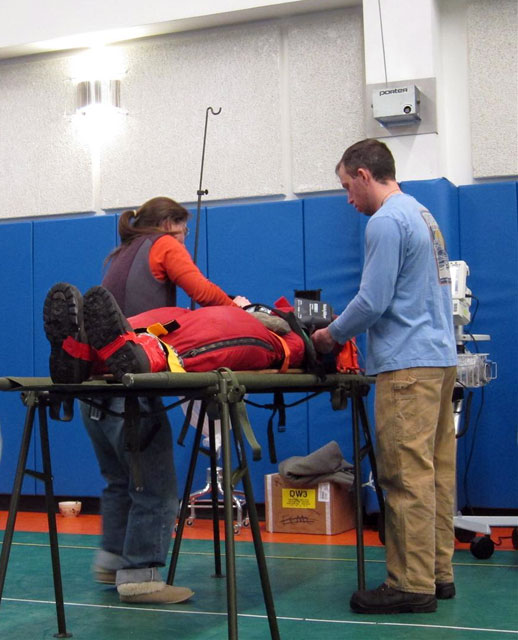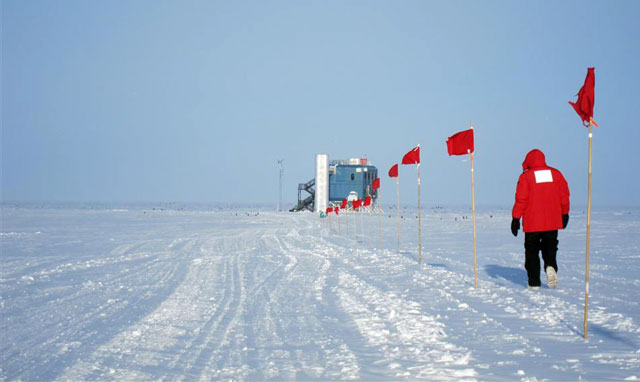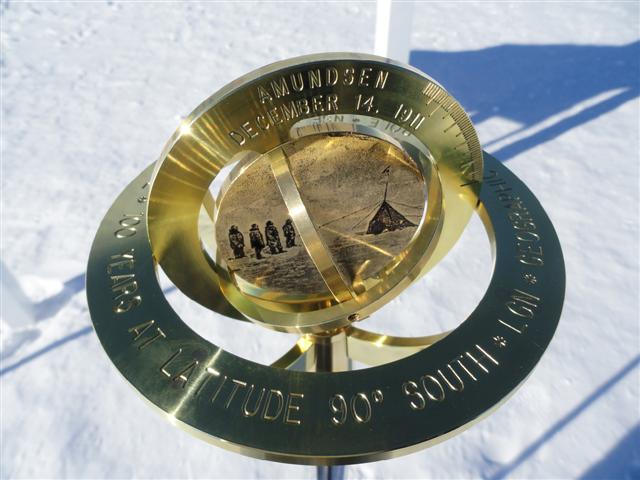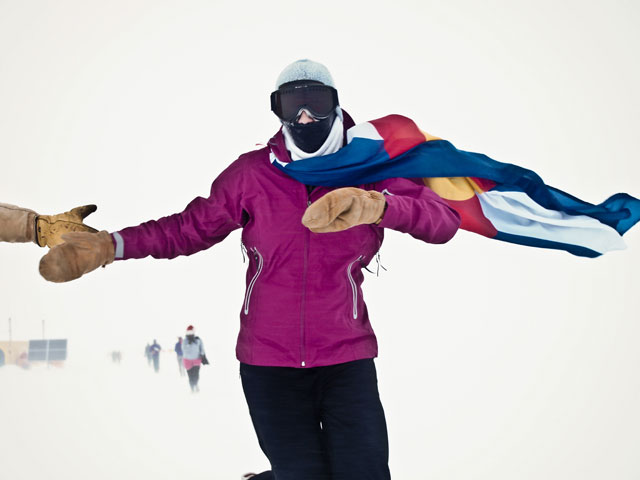|
South Pole Station Archives - 2012 South Pole turns the final page on winterPosted November 16, 2012
October was the last month of winter at the South Pole Station A clear indication that spring is in the air out in the real world is all the migrating birds that suddenly fill the skies. At the South Pole, there are no real birds; actually, there is nothing living here beside us. The only flying objects we see are all made of metal. But just like migrating birds, the “metal birds” that have long been absent have returned to the skies. Several small planes called Baslers and Twin Otters, used to support deep-field research across the continent, stopped by the South Pole to fuel, and to rest on their way to their summer locations. The final proof that winter is finally over was the arrival of the first “Herc,” or LC-130 October was another very busy month for us. Everything that we hadn’t done yet definitely needed to get done now, using up our last energy resources. For starters, the skiway had to be finished to enable all the metal birds to land. Everyone had to make preparations to turnover his or her job to the new summer arrivals. And then there was a lot of shoveling to unbury buildings and equipment, along with the usual sort of spring-cleaning of the station, work areas and our rooms – getting it all nice and shiny and ready for the summer. The Food Growth Chamber, which has spoiled us with fresh greens all winter, had its final harvest of the season. The result was one last Farmer’s Market, a lot of salad for our meals, and something of a reintroduction to the pleasures of civilization. The party of the month, of course, was on Halloween. The kitchen staff picked the three top places in a costume contest. Another highlight of the month was the Winter-over Ceremony, where the Antarctic Service Medals No metrological records were tied or broken in October, but the cold weather continued. The monthly average temperature being minus 0.5 degrees Celsius/minus 0.9 degrees Fahrenheit, which is colder than normal. Of course, it’s cold here no matter how you slice it, with the monthly average last month being minus 51.5C/minus 60.7F. Experiments kept collecting data. For BICEP2 Sun and smiles return to the South PolePosted October 26, 2012
The gloomy mood of August was replaced with sunny smiles in September, as the sun finally returned to the South Pole Station The U.S. Naval Observatory defines sunrise as when the leading edge of the sun clears the horizon, which happened here on Sept. 20. Unfortunately, on that day, any sunrise was obscured by clouds, strong winds and blowing snow. Luckily, there are different definitions to qualify when the sun actually rises. According to another definition, our sunrise is on the equinox, Sept. 22, which is when the sun is right over the equator and the top half is visible. With clear skies that day, we enjoyed that “sunrise” instead. As we have learned during the last couple of months, nothing is easy down here, apparently not event a sunrise. But, once again, we Polies adjusted and did the best we could with what we had to work with. Of course, the highlight on the social scene was the sunrise dinner, which featured a 50s theme. The kitchen staff not only provided typical diner food, but to our delight, they wore authentic diner attire as well. The alternate equinox sunrise offered another occasion to celebrate a couple of days later. This time, in a very relaxed manner, we stared out the dining room windows at the sun while enjoying snacks and drinks. One of the drinks was “gloegg,” a special recipe bequeathed to us from the Norwegian prime minster. The “secret” was passed on during last year’s centennial celebrations, to be used only on very special occasions. Other station recreational activities in September included bingo night, a farmer’s market in the Food Growth Chamber, and the usual movie nights and sports played in the gym. We also continued our ongoing race to McMurdo Station Just because the sun is up again doesn’t mean that our winter is over — far from it. We are now entering probably the most hectic period, with less than a month now to get everything ready for the first flights of the summer season. Activities include everything from snow removal to preparation of the skiway, along with cleaning and packing. Science keeps happening. This month a brief power outage on Sept. 25 caused some disturbance to an otherwise calm but very productive month of data collecting. For the NOAA Scientists with the IceCube Neutrino Observatory No weather records were tied or broken during September, but the average temperature was minus 60.7 degrees Celsius/minus 77.3 degrees Fahrenheit, which was minus 1.7C/minus 3.1F colder then the average for September. The coldest was Sept. 7, dropping to minus 74.7C/minus 102.5F. With the sun up, we won’t see any more auroras, to everyone’s big disappointment; therefore, some of our science projects are done for this year, while others that have been on hold during the winter are back up again. Science never sleeps at South Pole. South Pole gets into the act for Antarctic film festivalPosted September 14, 2012
In August, we continued a legacy started more than 100 years ago by the early polar explorers. They turned to culture, and wrote and performed plays to fight boredom, cold and darkness. A century later, some things have changed, while others have stayed the same. Thanks to video cameras, satellites and the Internet, we have all the necessary ingredients to bring Antarctic culture to the 21st century, and everything needed for a film festival — the Antarctic Winter International Film Festival (WIFF). Organized through McMurdo Station Several Polies worked on their films during the winter but unfortunately, not everyone submitted their movies. Still, this year’s film festival had 27 entries from 20 stations. For the 48-hour category, the film has to be filmed, edited and submitted within 48 hours, with requirements that certain elements are present in the film. This was the most popular category, and the film “Super Mario in Kergueland” took three awards and was also selected best film. This was an entry from a French research station on the subantarctic Kerguelen Islands. Several of the British entries related to James Bond, and if this year’s new James Bond movie is anything like these WIFF films, it will be a very entertaining film. The great creativity and hidden talent among the entries entertained us on a recent Saturday evening, and there was lots of laughter. This is the time of the year when the ozone hole starts to grow, and so the NOAA 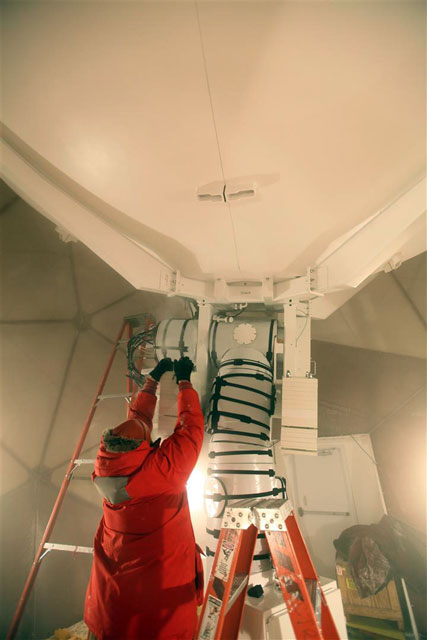
Photo Credit: Sven Lidstrom
Satellite engineer Jeremy Schultz replaces parts on a communications dish.
In late August, we were faced with yet another technical challenge. A wave-guide, used for transferring microwaves to the satellite dish, on our TDRS With all science data relying on TDRS for transfer and no spare parts to be found on station, we were facing severe impacts on operations for the last months of winter. But challenges are there to be overcome. Our station machinist, Derek Aboltins, spent a weekend fabricating the needed parts. Satellite engineer Jeremy Schultz then replaced the damaged components, and we were back to normal operations again within a week. With science continuously happening and creating lots of data to be transferred, this was a very important achievement. August was cold, about minus 3 degrees Celsius/minus 5.4 degrees Fahrenheit colder than average, and we broke two metrological records, both lowest daily temperature ever recorded. On Aug. 5, the temperature reached minus 75.1C/minus 103.2F and on Aug. 14 it reached minus 74.7C/minus 102.5F. At the end of August, we also experienced our second full moon for the month, a so-called blue moon. Most importantly, though, we have started to see light on the horizon, indicating the sun is gradually making its way closer to summer. It is probably about time, since it seems we have forgotten what the sun actually looks like. During the repairs on the TDRS dish, the domed shelter protecting the antenna was lit up. Apparently, the dome, located less than a mile from station, could, in the toasty mind of a winter-over at least, resemble the sun. During the repairs, a very excited voice announced on the all-call channel on the radio that the sun now was visible, weeks before it should be. This resulted in the entire station going outside staring at the satellite dome through the drifting snow and mist, until someone mentioned that the sun very much resembled the TDRS dome. Hopefully, in a couple of weeks, we will know what the real sun looks like. July is toughest month to winter-over at South PolePosted August 17, 2012
July is probably the most difficult month for winter-overs at the South Pole Station Toast is the not-so-medical term for the physical and psychological state you enter at some point during your winter. It is still dark and cold. Sunrise is still two months away. So you are starting to feel worn out, more tired and more than ready to leave. You are dreaming about when you can go somewhere warm and relaxing, where the sun always shines, and where you can take a three-minute shower without feeling guilty. 
Photo Credit: Sven Lidstrom
A Polie enjoys the aurora show in the Dark Sector at the South Pole Station.
The cure for winter-over toastiness is fun and entertainment. Last month, we tried our best to cure ourselves. It started out with the Vehicle Maintenance Facility crew hosting the Fourth of July party (on July 7). The party included everything you could ask for, except maybe the marching band: A barbecued full pig, burgers, cake and, of course, horseshoe and corn hole games. The Fourth of July fireworks came a couple of days later when AR1520, a big solar storm, hit us. The effects of solar storms can be seen on Earth as auroras, and South Pole in winter is a prime location for aurora watching. Even though AR1520 coincided with the coldest days so far this winter — we officially hit minus 76 Celsius/minus 104.8 Fahrenheit — it didn’t stop us from venturing outside to enjoy the skies going berserk above us. There were also several people proving that Polies are tougher than the rest — or crazier, some would say — since they decided that camping outside is the way to truly enjoy South Pole at below minus 100F. Another big entertainment event in July was South Pole Open Mic Night, when we enjoyed live music, wild stories and other fun things. A big surprise for all of us who are not talented enough to perform was that we all got backstage passes so we could go party with the “stars.” This was a first for me, and I had very high expectations, since you hear a lot about what goes on backstage. And I wasn’t disappointed, although a bit surprised: Rock stars these days party on “fresh” milk — well, Ultra High Temperature (UHT) processed milk is considered fresh after months of the powdered type of milk we are used to — and freshly baked chocolate brownies. It was not what I expected, but definitely what I wanted. The last weekend in July brought the monthly Farmer’s Market in the Food Growth Chamber, followed by Superhero Bingo Night. During July, no weather records were either tied or broken. The average temperature for the month was minus 60C, which is a little colder than normal. Science continues to happen, and this month it happened with minimal technical problems, which allowed Derek Aboltins, our science machinist, time to work on the geographic marker that will be unveiled on Jan. 1, 2013. The monthly emergency response drill took place in the station subfloor, which is a very shallow and tight space below our normal floor. For some reason, both victims and responders turned out being the biggest and heaviest on station, which added to the complexity of the response. A few technical challenges hit the station experiments in JunePosted July 20, 2012
The main event at South Pole Station It will still be months before we will see it again, but at least it’s a turning point, and we all now have a bright, sunny future ahead of us. A committee was formed to plan the event, and they came up with so many great ideas that it turned into a two-day celebration, and we still had to postpone some activities for later. 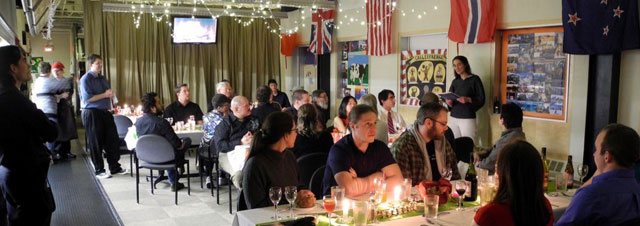
Photo Credit: Sven Lidstrom
Katie Hess, at right standing, gives a speech at the South Pole Midwinter celebration.
The celebration started with a brunch in the station’s hydroponic greenhouse, where its produce was turned into different delicacies. To allow for the food to settle, the afternoon was spent at our very own drive-in movie theater — aka, the gym, which had been turned into a state-of-the-art movie theatre for the occasion. As tradition dictates, we watched “The Shining.” Then the main event followed: Midwinter dinner. This proved to be another culinary extravaganza by our kitchen staff. Five plated courses, served by real waiters and waitresses, added to the experience. After dinner, with the night still young — we still have another couple of months of it — there was an 80s dance party to get rid of those extra pounds. Or, if you were too full to even move, there were late-night movies in the gym. A nice thing with Midwinter is all the greetings we get — from the White House to Japanese ministers, from previous winter-overs to all the other stations on the continent. The latter are extra fun because they normally include photos of the station and its surroundings, as well as the winter-over crew, although some were a bit disturbing to see, since they were standing outside in T-shirts among penguins in sunlight. Their winter-over experience must be a very different one than ours. [See related article — Waiting for the sun: Antarctic research stations observe winter solstice.] Science continues apace, but in June, it required more intervention than normal to make it happen because some of our telescopes had some challenges. The South Pole Telescope The South Pole Upgrades for DASI (SPUD) Weather-wise, June was 1.1 degrees Fahrenheit warmer than normal, and we broke or tied four weather records. The coldest temperature recorded was on June 13 at minus 101.4F. May was a 'super' month at South Pole StationPosted June 15, 2012
Last month was pretty super at the South Pole Station Early May brought a super moon, which is when all forces in the solar system come together to help Polies see what they are actually doing when working outdoors during the 24-hour darkness of winter. (It’s also the informal term used to describe when a new or full moon makes its closest orbital pass by the Earth, appearing huge in the sky.) 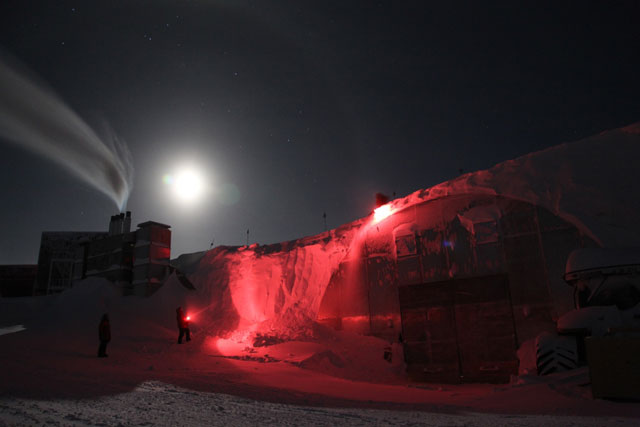
Photo Credit: Sven Lidstrom
South Pole workers use the light of the moon to work during the winter darkness.
After weeks of walking and working in the dark, or perhaps guided by the faint red light of a headlamp, we could all of a sudden see what we were doing and where we were going. We took advantage of this extra moonlight and completed as much of our scheduled outside work as possible. It is amazing how small things like actually seeing what you are doing can make your day. Weather-wise, May was an average month, with no meteorological records tied or broken. Science continues to happen at South Pole. IceCube Otherwise, the big recreational event has been the start of the South Pole 8-Ball Pool Tournament. Nearly half the station participates in a very comprehensive schedule, which will keep us playing pool until sunrise, making our already busy recreational schedule even busier. In order to get all participants in the right mood, a bar has been built and installed in the station’s game room. Another big event, using the creativity of the winter-overs, was the Pole Marker competition. The geographic South Pole marker, marking the actual South Pole during 2013, is designed by South Pole winter-overs, who then vote on the final design. [See previous article — A good point: South Pole geographic marker changes with the times.] Once the winning design has been selected and approved, it will be made by the station machinist, Derek Aboltins. The rest of the world will see the new Pole marker for the first time on Jan. 1, 2013, when it will be uncovered during the moving of the Pole. All Polies are members of one of the station’s emergency response teams, covering every possible type of emergency we could encounter. Every week, since we arrived at station, we have been training and fine-tuning our skills to be ready in case of a disaster. All our training came to use during the mass casualty incident (MCI) drill we had at the end of the month. The purpose of an MCI is to have the different teams interact, while coping with an emergency that is so serious that we are stretching the limits of our resources to the maximum. The drill scenario was an electrical fire in the power plant. The first responders found thick smoke and called on the fire team, which entered, put out the fire, and searched the building. They found four victims, who were handed over to the trauma team, which performed triage and then, with the help of the logistics team, evacuated the patients to the medical clinic for further treatment. The personal highlight of this month was a harvest at the greenhouse, which continues to spoil us. This time it gave us the most amazingly tasty strawberries — pretty super indeed for a winter at the South Pole. Signs of winter appear above the South PolePosted May 18, 2012
April was a month of transition at the South Pole Station For many it was a transition from one employer to another, with the turnover of the U.S. Antarctic Program It was also a transition from cold to colder with the sun below the horizon. We reached minus 100 degrees Fahrenheit on April 7, which is the earliest date ever recorded. Normally minus 100F is not reached until May. [See previous article — Cold front: South Pole hits minus 100F mark earliest ever in the winter.] This enabled the bold and brave to join the very prestigious 300 Club. For a lifelong membership, you need to expose your body to a 300F temperature difference by stewing in a sauna for as long as possible and then walking to the geographic South Pole while wearing minimal clothing. The early membership drive for the 300 Club occurred while there was still a faint streak of orange twilight far in the horizon, and a full moon in the sky. Not surprisingly, April was nearly 4F colder than normal. With the colder temperatures, NOAA Also during April, we started seeing auroras to everyone’s delight. Anyone on station eager to see them can turn their hand radios to the “aurora channel” to get the “aurora alerts” so they know when it is worthwhile to go outside to view these spectacular displays. The station’s aurora cameras are now turned on to observe this phenomenon in detail. In April, the IceCube The dining hall window cover competition proved once again that the South Pole community is a group of very creative people with multiple talents and skills. Every winter we must carefully cover the station’s windows so no light disturbs the very light-sensitive experiments under way. In addition, the walls of the galley have been covered with the flags that flew at the ceremonial South Pole during the summer centennial celebrations for Roald Amundsen and Robert Scott. Easter was celebrated with a delicious traditional dinner prepared by our senior meteorologist Dale Herschlag, since our kitchen staff had the weekend off. We also celebrated the birthday of Yuri Gagarin, the first man in space, with the annual Yuri’s Night party. The 100th anniversary of the Titanic disaster was commemorated with an afternoon and evening filled with Titanic documentaries and movies. We also gathered for a night of Pub Trivia, as well for another Farmer’s Market for everyone to socialize and enjoy the greenhouse produce. Start of winter season brings change in fortunePosted March 16, 2012
South Pole Station Left behind for the winter are 50 brave souls from all over the United States and seven other countries. With the wide variety of skills and strengths among us, this will hopefully be a great experience for all of us. According to station tradition, we celebrated the first evening of winter by gathering in the gym after dinner to watch the sci-fi move The Thing — both the old and new versions. This might have changed a couple of people’s expectations of our coming winter, but now we know how to deal with alien monsters. However, we have yet to locate flamethrowers, as they are not in MAPCON, the U.S. Antarctic Program’s Since Feb. 15, we have been busy getting the station and ourselves ready for winter. We have another few weeks to finish up all outside work before the sun sets and leaves us all in the dark for the next six months. Fuel lines have been recovered, and summer camp (a small tent city used to house personnel in warmer months) has been closed down. We have put flag lines to all exterior buildings, and all loose equipment has been located, and either flagged or moved to keep it from disappearing during winter storms. The coldest temperature of the month was reached on Feb. 29 at minus 52 degrees Celsius, and we broke the previous daily peak wind speed records on Feb. 8 and Feb. 20 with 27 knots and 33 knots, respectively. We have also been able to recover from a very hectic summer season, and on Feb. 25 we celebrated Mardi Gras in true New Orleans spirit. But our happy mode was eclipsed when we found out about the fire at the Brazilian research station Comandante Ferraz, which claimed two lives and injured a third person. In honor of the injured and dead persons, we flew a Brazilian flag at the South Pole during the last week of February. In a small ceremony, it was taken down and folded according to protocol by winter site manager Katie Hess, science lead Heather Moe and station physician Dale Molé. The flag will later be presented to the Brazilian Antarctic program. Science is, as always, happening at the South Pole. Both Small Polarimeter Upgrade for DASI (SPUD) and the South Pole 10-meter The most important people on station for morale and our well-being are no doubt our kitchen staff. They have performed over and above all our expectations. It is hard to believe we are actually at the end of the world. The other night they cooked us yet another delicious dinner, this time on a Chinese theme. They even had some homemade fortune cookies. However, the fortunes were a bit darkly humored. My first fortune cookie said, “You have a long, dark and cold winter ahead of you.” A bit dissatisfied with that fortune, I decided to take another one, hoping for something a bit more encouraging. But my next fortune cookie said, “You should have gotten on that last plane.” Pole wraps up centennial year and prepares for winter hibernationPosted February 17, 2012
The South Pole continued to be the hottest tourism ticket in Antarctica as the new year got under way. Visitors used all manner of locomotion to get to the bottom of the world for the 100-year anniversary since the first men arrived at the South Pole. They used skis, trucks, and even a fat-tire bicycle. About 70 visitors were at the South Pole Station One venerable tradition — though not stretching back a century — is the placement of a new geographic marker at 90 degrees south. The ice sheet moves about 30 feet a year, so it is relocated every Jan. 1. The winter crew the previous year is responsible for designing and creating the marker. In recent years, the brass markers have become increasingly ornate, virtual works of art. This year’s was no different. Designed and built by machinist Steele Diggles, the 2012 marker is three-dimensional, honoring both Amundsen and Scott. The names of the 49 winter-overs from 2011 are inscribed along the base of the pole that supports the marker. A more recent tradition, also on Jan. 1, was the second annual South Pole Marathon, with four runners finishing all 26 miles at an altitude of more than 9,300 feet. The winning time was four hours and 27 minutes. But don’t think it was all fun and games at the South Pole in January. Some major science got done. The South Pole Telescope Station operations moved into preparing the upcoming winter season as the month drew to a close. The last flight of the summer left Feb. 15, leaving 50 people isolated at the bottom of the world for the next eight months. Expeditions continue to roll in to celebrate centennial at PolePosted January 13, 2012
December started out in a frenzy and never slowed down at the South Pole Station Expedition skiers and fly-in visitors began arriving en masse in early December, with many hunkering down at the visitor’s campground awaiting the 100-year anniversary of when the first people reached the South Pole, a group of Norwegians led by polar explorer Roald Amundsen. The occasion included a multiday visit by Norwegian Prime Minister Jens Stoltenberg 
Photo Credit: Peter Rejcek
The ice bust of Roald Amundsen sits on an ice pedestal at the ceremonial South Pole.
Events surrounding the big day included setting up a media shack near the ceremonial pole to conduct two days of live broadcasts back to Norway; creating an Amundsen ice bust, which the prime minister unveiled on the big day; and planning the ceremony marking Amundsen’s arrival at the South Pole on Dec. 14, 1911. [See related article — South Pole anniversary: Norwegian prime minister visits bottom of the world to honor Amundsen.] After the ceremony, Stoltenberg hosted a reception and dinner at the station. A mixer for visitors and science personnel was also included in the day’s events at the last minute, and it turned out to be a big hit with our visitors. Community members and visitors alike participated in some or all of the events, and it was without a doubt a joyous and historical time to be at the Pole — a far different place than when Amundsen found it a century ago using dogsleds. The prime minister gifted a Norwegian flag to the South Pole Station, with Bill Coughran, South Pole Area Director, committing that the station would fly the flag every year on Dec. 14 in honor of Amundsen’s achievement. After the centennial celebrations, expeditions continued to make their way to South Pole, keeping station personnel busy, in addition to keeping excitement high through the Christmas holidays. All of the South Pole Christmas traditions took place. The station kitchen staff pulled off another exceptional holiday meal for nearly 250 people without a hitch. Christmas carolers sent their holidays songs across VHF radio, while the intrepid braved a blizzardy day to participate in the annual Race Around the World. Then a truly strange thing happened on Christmas Day. It got hot — well, warm for the South Pole, with a new record high of about 10 degrees Fahrenheit. [See related article — Heat wave: South Pole hits record high temperature on Christmas Day.] Most Polies will say they’ve never seen temperatures at the Pole above 0 degrees , making it a welcome holiday surprise. On Dec. 27, the second South Pole Operations Traverse arrived with fuel and cargo, which surely means the 2011-12 field season will begin winding down soon. But not before we welcome in a new year with more visitors, many of whom will hope to be here on Jan. 17, to mark the arrival of Briton Robert F. Scott and his men to the South Pole a century ago. |
Home /
Around the Continent /
South Pole Station Archives - 2012
"News about the USAP, the Ice, and the People"



For USAP Participants |
For The Public |
For Researchers and EducatorsContact UsNational Science FoundationOffice of Polar Programs Geosciences Directorate 2415 Eisenhower Avenue, Suite W7100 Alexandria, VA 22314 Sign up for the NSF Office of Polar Programs newsletter and events. Feedback Form |

